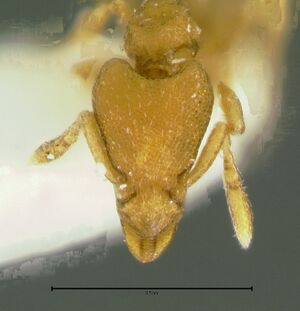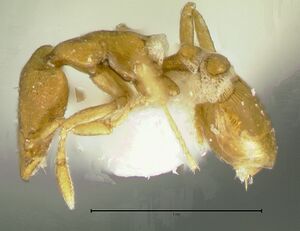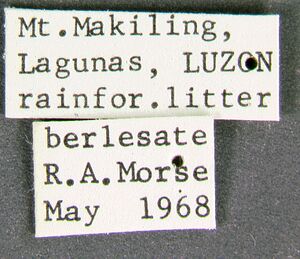Strumigenys mitis
| Strumigenys mitis | |
|---|---|

| |
| Scientific classification | |
| Kingdom: | Animalia |
| Phylum: | Arthropoda |
| Class: | Insecta |
| Order: | Hymenoptera |
| Family: | Formicidae |
| Subfamily: | Myrmicinae |
| Tribe: | Attini |
| Genus: | Strumigenys |
| Species: | S. mitis |
| Binomial name | |
| Strumigenys mitis (Brown, 2000) | |
A rainforest species that is typically found in litter-samples. In Hong Kong, although this species is not among the most commonly collected, it was found in a wide range of habitats and elevation, including grasslands, shrublands, tree plantations (e.g. L. confertus), and secondary forest at elevation ranging from 70 to 809m (Tang et al., 2019). Colonies apparently can be relatively small in size with about 50 individuals (Mezger and Pfeiffer 2008). Collected in secondary forest, rubber and agro-rubber plantations in South China, and similar habits in Thailand and Vietnam. Known elevation from 30 to 897 m (Tang & Guenard, 2023).
Identification
Bharti & Akbar (2013) - The only member of the Strumigenys mitis-group. This small slender species is very widely distributed in the Oriental and Malesian regions. The species is easily recognized by its dorsal surfaces of middle and hind tibiae without laterally projecting long hairs anterior clypeal margin convex. Pronotal humeral hair absent. First gastral tergite without standing hairs. Base of first gastral sternite without spongiform tissue. Lateral clypeal margins without projecting hairs. With head in full-face view dorsolateral margin of occipital lobe without projecting hairs. It is one of the most commonly encountered members of the genus in Winkler bag samples made in these areas. A very complex species group with great variations, gyne polymorphism and even suspected social parasitism (Bolton, 2000).
Related Species
An undescribed species near S. mitis.
Keys including this Species
- Key to Strumigenys of China (as Pyramica)
- Key to Strumigenys of East Asia (as Pyramica)
- Key to Strumigenys of India
Distribution
This species is widely distributed within the regions studied, including Guangdong and Yunnan provinces of mainland China as well as Vietnam. Its records in Hainan and Guangxi provinces were expected. Based on our current understanding of the distribution of this species, it seems likely to be also present in Cambodia, Laos, Myanmar, Bangladesh and some of the eastern states of India (Manipur, Meghalaya, Nagaland, Tripura) (Tang & Guenard, 2023).
Latitudinal Distribution Pattern
Latitudinal Range: 22.4291° to 0.566666667°.
| North Temperate |
North Subtropical |
Tropical | South Subtropical |
South Temperate |
- Source: AntMaps
Distribution based on Regional Taxon Lists
Indo-Australian Region: Brunei Darussalam, Indonesia, Malaysia, New Guinea, Philippines (type locality), Singapore.
Oriental Region: India, Thailand, Vietnam.
Palaearctic Region: China.
Distribution based on AntMaps
Distribution based on AntWeb specimens
Check data from AntWeb
Countries Occupied
| Number of countries occupied by this species based on AntWiki Regional Taxon Lists. In general, fewer countries occupied indicates a narrower range, while more countries indicates a more widespread species. |

|
Estimated Abundance
| Relative abundance based on number of AntMaps records per species (this species within the purple bar). Fewer records (to the left) indicates a less abundant/encountered species while more records (to the right) indicates more abundant/encountered species. |

|
Biology
Castes
Worker
   
| |
| . | Owned by Museum of Comparative Zoology. |
Nomenclature
The following information is derived from Barry Bolton's Online Catalogue of the Ants of the World.
- mitis. Pyramica mitis Brown, in Bolton, 2000: 442, figs. 267, 290 (w.q.) PHILIPPINES. Combination in Strumigenys: Baroni Urbani & De Andrade, 2007: 124
Taxonomic Notes
Tang & Guenard (2023) - It has been proposed by Bolton (2000) that S. mitis is not a single species, but a multitude of species that likely can only be morphologically differentiated from one another based on queen castes. A single queen has recently been collected in an urban park in Hong Kong (Fig. 31), which shows a morphology close to Queen morph B described by Bolton, but additionally, also presents a peculiar color pattern on the cephalic dorsum. Unless otherwise noted the text for the remainder of this section is reported from the publication that includes the original description.
Description
Worker
Holotype. TL 1.9, HL 0.49, HW 0.33, CI 67, ML 0.09, MI 18, SL 0.25, SI 75, AL 0.52. Head in full-face view slender and, with the closed mandibles, cuneiform. Dorsolateral margins of head rounded at their maximum width. From its widest part the sides of the head converge in an almost straight outline to the mandibles. In profile the head depressed and its dorsal outline nearly flat, only very feebly convex; the clypeal and mandibular dorsal surfaces continue the line. Eyes visible in full-face view, their outer margins projecting beyond the dorsolateral margins of the head. Cephalic dorsum finely and densely reticulate-punctate. Pronotum in dorsal view elliptical anteriorly, the humeri not angulate. Metanotal groove absent. Dorsal alitrunk reticulate-punctate but sides mostly smooth and shining. Petiole node in profile narrowly rounded, in dorsal view slightly broader than long and flanked by conspicuous lateral spongiform lobes. Disc of postpetiole transverse, enveloped in voluminous spongiform lobes. Dorsum of petiole node weakly reticulate-punctate; disc of postpetiole mostly smooth but with some very fine obscure sculpture anteriorly. Basigastral costulae fine and numerous, behind them the tergite smooth and shining.
Paratypes. TL 1.5-1.9, HL 0.43-0.49, HW 0.29-0.33, CI 65-70, ML 0.05-0.09, MI 12-18, SL 0.20-0.25, AL 0.41-0.52 (14 measured).
Dimensions of non-paratypic workers. TL 1.4-1.9, HL 0.39-0.51, HW 0.28-0.35, CI 65-75, ML 0.05-0.09, MI 12-20, SL 0.18-0.25, SI 63-75, PW 0.18-0.22, AL 0.38-0.52 (40 measured).
Queen
Based on the workers only one species is currently recognised in this group, distributed over a vast range. I am sure that this does not reflect the true taxonomic situation. Eleven series of mitis workers have at least one queen in association, and this caste shows so much variation, in characters that are usually very important and stable in Pyramica, that I am convinced that several species are compounded here. However, as only 16 queens in total are known, and variation is so marked, no definite statements about what constitute real species can yet be made. The sorting of this tangle is made more difficult as I suspect that some degree of queen polymorphism may also be present, as may at least one social parasite. As the workers are so conservative in their features real characters that segregate them into species cannot be estimated until more is known about character stability in the queens. And this cannot be estimated until more series with queens and workers in association have been amassed.
The currently available queens can be divided roughly into five morphs, as discussed below. This segregation is provisional. I do not claim that the characters utilised represent any formal taxonomic rank; there is not enough material to substantiate such a claim.
Queen morph A (1 specimen: Sulawesi; in ANIC).
Head and dorsal alitrunk glassy smooth. Entire dorsum of head very densely clothed with mostly straight suberect hairs. Ventral surface of head with abundant similar hairs and with several pairs of much longer sinuate to flagellate hairs. All other queens (morphs B-E) have strongly sculptured head and dorsal alitrunk and lack this form of cephalic pilosity.
Queen morph B (4 specimens: West Malaysia; in BMNH).
The pronotal humeri do not have flagellate or elongate stiff filiform hairs present. All other samples possess such hairs (flagellate in morphs C and E, stiff and filiform in morphs A and D).
Queen morph C (2 specimens: Sarawak; in BMNH and MCZ).
With the head in full-face view the lateral margin of the occipital lobe does not have long simple hairs that project from the margin and curve anteriorly. Such hairs are also absent in morph B but present in morphs D and E.
Queen morph D (1 specimen: Bali; in AMNH)
Pronotal humeri with stiff filiform hairs. Lateral margin of occipital lobe with many short curved simple hairs. Leading edge of scape and all segments of legs with abundant suberect stiff projecting short hairs. Entire dorsum of head and body very densely clothed with short stiff suberect to erect hairs.
Queen morph E (8 specimens: Philippines, Singapore, West Malaysia, Sabah, Java, Sulawesi; in BMNH and MCZ).
Pronotal humeri with flagellate hairs. Lateral margin of occipital lobe with 1-2 long, anteriorly curved fine simple hairs present.
No two series within morph E have queens that are exactly alike. For instance specimens from Java (2; in BMNH and MCZ) and Sulawesi (1; in BMNH) are small (worker HW 0.33-0.34, queen HW 0.36-0.40) and have numerous flagellate hairs arising from the dorsal mesoscutum. These are lacking or sparse in other morph E specimens. The Java queens have dense, sharply defined basigastral costulae whereas the Sulawesi queen has them very faint, short and poorly defined. None of them has flagellate hairs arising from the dorsal (outer) surface of the hind tibia. None of them has long straight fine hairs projecting forward from the leading edge of the scape.
Queens from Singapore (1; in MCZ) and Philippines (2; in MCZ) are also small (worker HW 0.30-0.32, queen HW 0.32-0.34), but they have long projecting hairs at the midlength of the dorsal (outer) surface of the hind tibia and on the leading edge of the scape; such hairs are more numerous in the former than in the latter. Basigastral costulae are sharply defined, long and directed straight backward.
A projecting tibial hair occurs in a large queen from Sabah (1; in BMNH; worker HW 0.32, queen HW 0.37), but not in an even larger specimen from West Malaysia (1; in BMNH; worker HW 0.34, queen HW 0.40). Both lack projecting hairs on the scape and in both the basigastral costulae are feebly developed, but in the West Malaysian queen they are oblique, slanting toward the midline. This specimen is also the only one that shows sculpture on the postpetiole disc, though the disc in associated workers remains smooth.
Type Material
Holotype worker, Philippines: Luzon, Lagunas Prov., Mt Makiling, vi.1966, rain forest, berlesate (K. Dumont & R. Morse) (Museum of Comparative Zoology).
Paratypes. Numerous workers and 3 queens (dealate) with same data as holotype and some with same data but v. 1968 (R.A. Morse) (MCZ, The Natural History Museum, Australian National Insect Collection).
References
- Baroni Urbani, C. & De Andrade, M.L. 2007. The ant tribe Dacetini: limits and constituent genera, with descriptions of new species. Annali del Museo Civico di Storia Naturale “G. Doria” 99: 1-191.
- Bharti, H. & Akbar, S.A. 2013. Taxonomic studies on the ant genus Strumigenys Smith, 1860 (Hymenoptera, Formicidae) with report of two new species and five new records including a tramp species from India. Sociobiology. 60:387-396. (doi:10.13102/sociobiology.v60i4.387-396).
- Brown, W. L., Jr. 2000. [Untitled. Mitis-group. Pyramica mitis Brown sp. n.] Pp. 441-443 in: Bolton, B. 2000. The ant tribe Dacetini. Memoirs of the American Entomological Institute. 65:1-1028. (page 441, figs. 267, 290 worker described)
- Khachonpisitsak, S., Yamane, S., Sriwichai, P., Jaitrong, W. 2020. An updated checklist of the ants of Thailand (Hymenoptera, Formicidae). ZooKeys 998, 1–182 (doi:10.3897/zookeys.998.54902).
- Mezger, D. & Pfeiffer, M. 2008. Record of a mixed colony of two dacetine species: Strumigenys rotogenys and Pyramica mitis (Myrmicinae) from Gunung Mulu National Park, Sarawak, Malaysia. Asian Myrmecology. 2:125-127.
- Musfira, S.H., Rafi, M., Gusti, M., Putri, D.H., Satria, R. 2022. New data on the genus Strumigenys (Hymenoptera: Formicidae) from Sumatra. Zoosystematica Rossica 31(1): 74–86 (doi:10.31610/zsr/2022.31.1.74).
- Tang, K. L., Guénard, B. 2023. Further additions to the knowledge of Strumigenys (Formicidae: Myrmicinae) within South East Asia, with the descriptions of 20 new species. European Journal of Taxonomy 907, 1–144 (doi:10.5852/ejt.2023.907.2327).
- Tang, K.L., Pierce, M.P., Guénard, B. 2019. Review of the genus Strumigenys (Hymenoptera, Formicidae, Myrmicinae) in Hong Kong with the description of three new species and the addition of five native and four introduced species records. ZooKeys 831: 1–48 (DOI 10.3897/zookeys.831.31515).
- Wang, W.Y., Soh, E.J.Y., Yong, G.W.J., Wong, M.K.L., Benoit Guénard, Economo, E.P., Yamane, S. 2022. Remarkable diversity in a little red dot: a comprehensive checklist of known ant species in Singapore (Hymenoptera: Formicidae) with notes on ecology and taxonomy. Asian Myrmecology 15: e015006 (doi:10.20362/am.015006).
References based on Global Ant Biodiversity Informatics
- Alcantara M. J., S. Modi, T. C. Ling, J. Monkai, H. Xu, S. Huang, and A. Nakamura. 2019. Differences in geographic distribution of ant species (Hymenoptera: Formicidae) between forests and rubber plantations: a case study in Xishuangbanna, China, and a global meta-analysis. Myrmecological News 29: 135-145.
- Bharti H., S. A. Akbar. 2013. Taxonomic studies on the ant genus Strumigenys Smith, 1860 (Hymenoptera, Formicidae) with report of two new species and five new records including a tramp species from India. Sociobiology 60: 387-396.
- Bolton, B. 2000. The Ant Tribe Dacetini. Memoirs of the American Entomological Institute 65
- CSIRO Collection
- Dad J. M., S. A. Akbar, H. Bharti, and A. A. Wachkoo. 2019. Community structure and ant species diversity across select sites ofWestern Ghats, India. Acta Ecologica Sinica 39: 219–228.
- Eguchi K.; Bui T. V.; Yamane S. 2011. Generic synopsis of the Formicidae of Vietnam (Insecta: Hymenoptera), part I Myrmicinae and Pseudomyrmecinae. Zootaxa 2878: 1-61.
- Fayle T. M., D. P. Edwards, E. C. Turner, A. J. Dumbrell, P. Eggleton, and W. A. Foster. 2012. Public goods, public services and by-product mutualism in an antfern symbiosis. Oikos 121(8): 1279-1286.
- Fontanilla A. M., A. Nakamura, Z. Xu, M. Cao, R. L. Kitching, Y. Tang, and C. J. Burwell. 2019. Taxonomic and functional ant diversity along tropical, subtropical, and subalpine elevational transects in southwest China. Insects 10, 128; doi:10.3390/insects10050128
- Guénard B., and R. R. Dunn. 2012. A checklist of the ants of China. Zootaxa 3558: 1-77.
- Hashimoto Y., and M. Mohamed. 2011. Ground-dwelling ant diversity in Maliau Basin, Borneo: evaluation of hand-sorting methods to estimate ant diversity. Tropics 19(2): 85-92.
- Janda M., G. D. Alpert, M. L. Borowiec, E. P. Economo, P. Klimes, E. Sarnat, and S. O. Shattuck. 2011. Cheklist of ants described and recorded from New Guinea and associated islands. Available on http://www.newguineants.org/. Accessed on 24th Feb. 2011.
- Liu C, B. Guénard, F Hita Garcia, S. Yamane, B. Blanchard, and E. Economo. New records of ant species from Yunnan, China. Submitted to Zookeys
- Mezger D., and M. Pfeiffer. 2008. Record of a mixed colony of two dacetine species: Strumigenys rotogenys and Pyramica mitis (Myrmicinae) from Gunung Mulu National Park, Sarawak, Malaysia. Asian Myrmecology 2: 125-127.
- Mezger, D.; Pfeiffer, M. 2010. Ecological traits indicate niche differentiation in Bornean Dacetine species (Myrmicinae; Formicidae). Ecotropica 16: 51-57.
- Pfeiffer M., D. Mezger, and J. Dyckmans. 2013. Trophic ecology of tropical leaf litter ants (Hymenoptera: Formicidae) - a stable isotope study in four types of Bornean rain forest. Myrmecological News 19: 31-41.
- Pfeiffer M., and D. Mezger. 2012. Biodiversity Assessment in Incomplete Inventories: Leaf Litter Ant Communities in Several Types of Bornean Rain Forest. PLoS ONE 7(7): e40729. doi:10.1371/journal.pone.0040787
- Pfeiffer M., and D. Mezger. 2012. Biodiversity Assessment in Incomplete Inventories: Leaf Litter Ant Communities in Several Types of Bornean Rain Forest. PLoS ONE 7(7): e40729. doi:10.1371/journal.pone.0040990
- Pfeiffer M.; Mezger, D.; Hosoishi, S.; Bakhtiar, E. Y.; Kohout, R. J. 2011. The Formicidae of Borneo (Insecta: Hymenoptera): a preliminary species list. Asian Myrmecology 4:9-58
- Tang K.L., Pierce M.P., and B. Guénard. 2019. Review of the genus Strumigenys (Hymenoptera, Formicidae, Myrmicinae) in Hong Kong with the description of three new species and the addition of five native and four introduced species records. ZooKeys 831: 1-48.
- Woodcock P., D. P. Edwards, R. J. Newton, C. Vun Khen, S. H. Bottrell, and K. C. Hamer. 2013. Impacts of Intensive Logging on the Trophic Organisation of Ant Communities in a Biodiversity Hotspot. PLoS ONE 8(4): e60756. doi:10.1371/journal.pone.0060756
- Woodcock P., D. P. Edwards, T. M. Fayle, R. J. Newton, C. Vun Khen, S. H. Bottrell, and K. C. Hamer. 2011. The conservation value of South East Asia's highly degraded forests: evidence from leaf-litter ants. Phil. Trans. R. Soc. B. 366: 3256-3264.
- Woodcock P., D.P. Edwards, T.M. Fayle, R.J. Newton, C. Vun Khen, S.H. Bottrell, and K.C. Hamer. 2011. The conservation value of South East Asia's highly degraded forests: evidence from leaf-litter ants. Phil. Trans. R. Soc. B 366: 3256-3264.
- Xu Z. H., and X. G. Zhou. 2004. Systematic study on the ant genus Pyramica Roger (Hymenoptera, Formicidae) of China. Acta Zootaxonomica Sinica 29: 440-450.
- Xu Z. and X.-G. Zhou. 2004. Systematic study on the ant genus Pyramica Roger (Hymenoptera, Formicidae) of China. Acta Zootaxonomica Sinica 29(3): 440-450
- Xu Z. and X.-G. Zhou. 2004. Systematic study on the ant genus Pyramica Roger (Hymenoptera, Formicidae) of China. Acta Zootaxonomica Sinica 29(3): 440-450.
- Yamane S.; Bui T. V.; Ogata K.; Okido H.; Eguchi K. 2002. Ant fauna of Cuc Phuong National Park, North Vietnam (Hymenoptera: Formicidae). Bulletin of the Institute of Tropical Agriculture Kyushu University 25: 51-62.
- Zryanin V. A. 2011. An eco-faunistic review of ants (Hymenoptera: Formicidae). In: Structure and functions of soil communities of a monsoon tropical forest (Cat Tien National Park, southern Vietnam) / A.V. Tiunov (Editor). – M.: KMK Scientific Press. 2011. 277 р.101-124.



